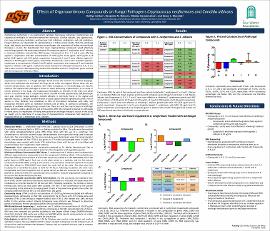| dc.contributor.advisor | Wozniak, Karen L. | |
| dc.contributor.author | Cotton, Kaitlyn | |
| dc.contributor.author | Nelson, Benjamin N. | |
| dc.contributor.author | Gerasimchuk, Nikolay | |
| dc.date.accessioned | 2022-05-12T12:40:29Z | |
| dc.date.available | 2022-05-12T12:40:29Z | |
| dc.date.issued | 2022-04-15 | |
| dc.identifier | oksd_Wentz_2022_cotton | |
| dc.identifier.citation | Cotton, K., Nelson, B. N., Gerasimchuk, N., & Wozniak, K. L. (2022, April 15). Effects of organoantimony compounds on fungal pathogens Cryptococcus neoformans and Candida albicans. Poster session presented at the Oklahoma State University Wentz Research Scholars Symposium, Stillwater, OK. | |
| dc.identifier.uri | https://hdl.handle.net/11244/335696 | |
| dc.description.abstract | Cryptococcus neoformans is an opportunistic pathogen that causes pulmonary cryptococcosis and cryptococcal meningitis in immune-compromised individuals. Candida albicans, also opportunistic, can cause pulmonary candidiasis, genitourinary tract infections, candidemia, and oral candidiasis. Fungal infections are responsible for approximately 1.7 million annual deaths. With few antifungal drugs, high toxicity, and increased resistance to antifungals, the importance of finding new antifungal therapies is crucial. We hypothesized that novel organoantimony compounds would effectively restrict fungal growth. We tested approximately 20 compounds against C. neoformans and C. albicans in minimum inhibitory concentration (MIC) assays. Compounds A, B, E, I, F, and G were effective against C. neoformans with MIC concentrations of 10.94 ug/ml, 19.79 ug/ml, 18.75 ug/ml, 12.5 ug/ml, 20.83 ug/ml, and 2.60 ug/ml, respectively. Compounds E and G were effective against C. albicans at 15.625 ug/ml and 25 ug/ml, respectively. Compounds I and G were fungicidal against C. neoformans at concentrations 50 ug/ml and 25 ug/ml, respectively, and compound G was fungicidal against C. albicans at 50 ug/ml. Cytotoxicity assays showed that antifungal compounds A, B, E, I, F, and G were non-toxic. RNA sequencing studies have identified several C. neoformans genes involved with the compounds' inhibitory effects. | |
| dc.description.sponsorship | Lew Wentz Foundation | |
| dc.format | application/pdf | |
| dc.language | en_US | |
| dc.publisher | Oklahoma State University | |
| dc.rights | In the Oklahoma State University Library's institutional repository this paper is made available through the open access principles and the terms of agreement/consent between the author(s) and the publisher. The permission policy on the use, reproduction or distribution of the article falls under fair use for educational, scholarship, and research purposes. Contact Digital Resources and Discovery Services at lib-dls@okstate.edu or 405-744-9161 for further information. | |
| dc.title | Effects of organoantimony compounds on fungal pathogens Cryptococcus neoformans and Candida albicans | |
| osu.filename | oksd_Wentz_2022_cotton.pdf | |
| dc.description.department | Microbiology and Molecular Genetics | |
| dc.type.genre | Poster | |
| dc.type.material | Text | |
| dc.type.material | Image | |
| dc.subject.keywords | antifungal | |
| dc.subject.keywords | Cryptococcus neoformans | |
| dc.subject.keywords | Candida albicans | |
| dc.subject.keywords | organoantimony | |
| dc.subject.keywords | mycology | |
